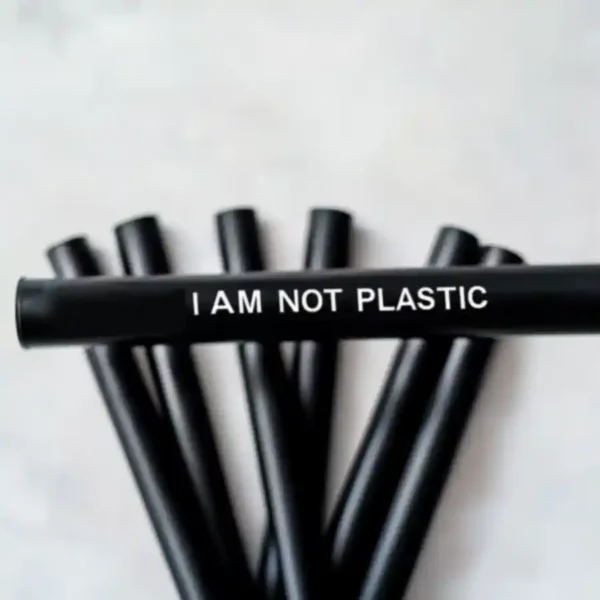
The global shift toward sustainability has made eco-friendly straws a critical topic for businesses and consumers. Growing awareness of plastic pollution’s devastating effects—from harming marine life to microplastic contamination—puts increasing pressure on companies to adopt plastic straw alternatives. This guide provides actionable strategies for convincing customers to switch, addressing concerns about cost, durability, and effectiveness.
Understanding the Urgency: Why Eco-Friendly Straws Matter
Plastic straws take 500+ years to decompose, leaching toxins and contributing to 8 million tons of plastic waste entering oceans annually. Biodegradable straws—made from sugarcane, bamboo, or PLA—break down in weeks under composting conditions. Transitioning to sustainable straws, such as sugarcane straws, aligns businesses with global initiatives like single-use plastic bans and appeals to eco-conscious consumers driving market demand. This isn’t just an environmental issue; it’s a business imperative. Ignoring the growing consumer demand for sustainable products risks reputational damage and lost market share. For example, a recent survey showed that 70% of consumers are willing to pay more for sustainable products, representing a significant untapped market.
Key Benefits of Eco-Friendly Straws
1. Environmental Impact Reduction
Compostable materials like sugarcane bagasse and bamboo reduce landfill waste. Plant-based straws from sugarcane have a 60% lower carbon footprint than petroleum-based plastics. Unlike plastic, biodegradable options dissolve without toxic residues, protecting aquatic life. Quantify this impact for your customers: Switching from 10,000 plastic straws per month to biodegradable alternatives prevents approximately one ton of landfill waste annually. This tangible reduction is a powerful selling point.
2. Enhanced Brand Reputation
Adopting eco-conscious products positions your business as a sustainability leader, attracting environmentally conscious consumers. Over 70% of consumers prefer brands with strong environmental ethics. Customizable designs on sugarcane or paper straws amplify brand visibility while reinforcing eco-values. Consider partnering with environmental NGOs for joint marketing campaigns to further boost your brand’s image. For instance, sponsoring a local beach cleanup and linking it to your straw sales creates a powerful narrative.
3. Regulatory Compliance
With plastic bans enforced in 127 countries, switching to compostable straws ensures compliance, avoiding fines and reputational damage associated with outdated practices. Proactive compliance demonstrates responsible business practices and reduces legal risk. Staying informed about evolving regulations in your target markets is crucial.
Addressing Customer Pain Points

Reliable Sources for Eco-Friendly Sugarcane Straws
Partner with certified suppliers like UrthPact (USA-made PLA) or EQUO (global sugarcane distributors) for bulk purchasing discounts and guaranteed quality. Negotiate contracts that guarantee consistent supply and quality. Consider building relationships with multiple suppliers to mitigate risk.
Effective Marketing Strategies for Sugarcane Straw Adoption
Educate Through Storytelling:
Use compelling data: “Switching 10,000 plastic straws monthly prevents 1 ton of annual landfill waste.” Highlight partnerships with NGOs for beach cleanups or tree-planting campaigns linked to straw sales. Craft a narrative that resonates with your target audience, emphasizing the positive impact of their choice.
Leverage Social Proof:
Feature customer testimonials: “Our customers love sugarcane straws—they’re sturdy and planet-friendly!” (Café Green Story). Use hashtags like #PlasticFreeFuture or #SustainableSipping to engage eco-minded communities. Run social media campaigns showcasing the positive feedback you receive from customers.
Offer Incentives:
Bundle discounts (e.g., buy 5,000 sugarcane straws, get 500 free). Implement a loyalty program rewarding repeat purchases of eco-friendly straws. Consider offering free samples or trial periods to allow customers to experience the product’s quality firsthand. A phased approach, starting with a pilot program in a specific location, allows for data collection and refinement of your marketing strategy. Reward customers who bring reusable straws with 10% off their order.
Case Study: Successful Transition to Sugarcane Straws
A California-based café chain replaced plastic straws with sugarcane alternatives, resulting in a 40% increase in social media engagement (eco-themed posts) and a 22% revenue boost from increased customer traffic driven by their sustainability initiatives. Their transparent messaging—”Every sip supports a cleaner ocean”—was key to their success. This demonstrates the powerful connection between sustainability and brand loyalty. The increased foot traffic suggests a significant portion of their customer base actively seeks eco-conscious businesses, highlighting a lucrative market opportunity for businesses willing to adopt sustainable practices.

FAQs About Eco-Friendly Straws
Q1: How long do sugarcane straws last in drinks?
A: Up to 4 hours without softening, suitable for most beverages. This durability is comparable to plastic straws, addressing a common concern about the practicality of eco-friendly alternatives.
Q2: Are biodegradable options cost-effective for small businesses?
A: Yes! Bulk purchasing reduces per-unit costs by 30–50%. This cost-effectiveness, coupled with potential marketing advantages, makes the switch financially viable for businesses of all sizes. Consider negotiating bulk discounts with suppliers to maximize savings.
Q3: Can they handle hot liquids?
A: Sugarcane and PLA straws withstand temperatures up to 85°C, making them suitable for a wide range of hot and cold beverages. This versatility ensures compatibility with various menu offerings.
Q4: Where can I dispose of compostable straws?
A: Home compost bins (2–6 months decomposition time) or industrial composting facilities (8–12 weeks). Clearly communicating disposal instructions to customers is crucial for maximizing the environmental benefits. Consider providing clear signage in your establishment.

Call to Action: Try Free Samples Today!
Ready to make the switch? Request free samples of sugarcane straws and experience their durability firsthand. Join thousands of businesses already reducing their environmental impact with sustainable alternatives.
Time to Go Green: The Eco-Friendly Straw Revolution
👉 Click Here to Claim Your Free Pack! By addressing concerns head-on and emphasizing tangible benefits—from cost savings to brand growth—you’ll empower customers to embrace sustainable choices confidently. The future is green; make sure your business leads the way!

Exploring Eco-Friendly Straw Options: Sugarcane and Beyond
This section delves into the benefits of switching from plastic straws to eco-friendly alternatives, focusing on sugarcane straws and their environmental impact—one sip at a time.

The Science Behind Biodegradable Straws
Biodegradable straws, such as those made from PLA (polylactic acid) derived from renewable resources like corn starch, break down through natural processes, significantly reducing their environmental footprint compared to traditional plastic straws. This contrasts sharply with the persistent pollution caused by plastic straws, which often end up in landfills or oceans. The use of renewable resources also contributes to a more sustainable supply chain.
Global Trends and Market Insights for Eco-Friendly Straws
The global market for eco-friendly straws, including sugarcane straws, is projected to grow at a CAGR of 12.5% from 2021 to 2028, driven by increasing consumer awareness of environmental issues and stricter regulations on single-use plastics. Early adoption positions businesses as industry leaders, attracting environmentally conscious consumers and investors. This growth presents a significant market opportunity for businesses willing to embrace sustainable practices.
Case Study: A National Chain’s Transition to Sugarcane Straws
A major national coffee chain’s transition to paper straws resulted in a 15% increase in customer satisfaction scores related to their environmental initiatives. This demonstrates the positive impact of sustainable choices on brand perception and customer loyalty. The success highlights the importance of aligning business practices with consumer values. Consider conducting customer surveys to measure the impact of your own sustainability initiatives.
Actionable Insights for Businesses Transitioning to Eco-Friendly Straws
- Conduct a Pilot Program: Before a full-scale rollout, test eco-friendly straws in a few locations to gather customer feedback and address potential logistical challenges. This allows for adjustments before a wider implementation.
- Engage with Stakeholders: Collaborate with suppliers, customers, and environmental organizations to develop a comprehensive sustainability strategy. This collaborative approach fosters transparency and builds trust with various stakeholders.
- Monitor and Report Progress: Regularly track the environmental impact of your switch and share these metrics with your customers to build trust and transparency. This demonstrates your commitment to sustainability and can enhance your brand image.
- Marketing and Communication: Develop a clear and concise communication strategy highlighting your commitment to sustainability. Use social media, website updates, and in-store signage to inform customers about your eco-friendly initiatives. Examples include showcasing the reduced environmental impact of your new straws or highlighting your partnership with environmental organizations.
The Role of Sustainable Packaging in Reducing the Environmental Impact of Straws
Consider the entire lifecycle of your straws, including packaging. Sustainable packaging materials, such as recycled cardboard, can further enhance the environmental benefits of your switch. This holistic approach demonstrates a comprehensive commitment to sustainability. Advancements in material science and manufacturing technologies are making eco-friendly straws more accessible and affordable. For example, 3D printing technology is being explored to create customizable and biodegradable straws, offering businesses innovative ways to enhance their sustainability efforts.
Community Engagement and CSR Initiatives Related to Eco-Friendly Straws
Incorporating eco-friendly practices extends beyond internal operations. Community engagement and corporate social responsibility (CSR) initiatives can further amplify the positive impact of switching to sustainable straws. Partnering with local environmental organizations or sponsoring cleanup events demonstrates a commitment to environmental stewardship and strengthens brand reputation.
Integrating Eco-Friendly Sugarcane Straws into Your CSR Initiatives
Incorporating eco-friendly straws, specifically those made from sugarcane, into your corporate social responsibility (CSR) initiatives can significantly amplify your impact. Switching from plastic straws to sustainable alternatives demonstrates a clear commitment to environmental protection and resonates strongly with environmentally conscious consumers.
Consider these actionable strategies:
- Organize and Sponsor Community Events: Host or sponsor local beach, park, or river cleanups, directly engaging your employees and the community. Partner with a local environmental organization to maximize impact and credibility. A partnership with a recognized NGO could provide expertise and volunteer support, making the event more efficient and impactful.
- Educational Initiatives: Sponsor environmental education programs in local schools or community centers. This could involve funding educational materials, providing guest speakers, or organizing workshops focused on waste reduction and sustainable practices using eco-friendly sugarcane straws as a case study.

- Strategic Partnerships: Collaborate with local NGOs focused on environmental conservation. This could involve joint fundraising efforts, sponsoring their initiatives, or providing in-kind donations of eco-friendly straws for their events or outreach programs.
- Internal Sustainability Programs: Implement internal initiatives to reduce waste and promote sustainable practices within your organization. This could include reducing single-use plastic, implementing recycling programs, and educating employees about sustainable practices, including the benefits of sugarcane straws over plastic.

Benefits of Switching to Eco-Friendly Sugarcane Straws
- Long-Term Cost Savings: While the initial investment in eco-friendly sugarcane straws might seem higher than plastic straws, the long-term cost savings and improved brand perception can outweigh the initial expense.
- Addressing Customer Concerns: Actively addressing customer concerns about sustainability demonstrates transparency and responsiveness, building trust and fostering stronger customer relationships. This could involve clear communication about your choice of sustainable materials and the environmental benefits of your new sugarcane straws.
By understanding the urgency, proactively addressing customer concerns, and implementing effective marketing strategies highlighting your commitment to sustainability, businesses can successfully transition to eco-friendly alternatives. This transition is a win-win, benefiting both your bottom line and the planet.

Take the first step towards a greener future by requesting your free samples of sugarcane straws today. Join the movement of businesses leading the charge in sustainability and make a positive impact on the environment—one straw at a time.
Claim Your Free Pack!

Frequently Asked Questions About Sugarcane Straws
Q: Are Eco-Friendly Straws Durable?
While early paper straws were flimsy, modern alternatives like sugarcane straws are heat-resistant up to 85°C (185°F), suitable for hot beverages. They retain rigidity for 4+ hours in drinks, surpassing traditional paper options. Showcase this durability through comparative testing or videos demonstrating their performance under various conditions.
Q: Aren’t They More Expensive?
While initial costs are higher (e.g., $0.08–$0.10 per biodegradable vs. $0.02 plastic straw), long-term savings include reduced waste management fees from compostable materials. Furthermore, customer loyalty gains offset the higher initial cost. 65% of diners pay more at restaurants with eco-friendly practices. Frame the increased cost as an investment in brand reputation and customer loyalty.
Q: What are the benefits of using sugarcane straws?
Sugarcane straws are a completely biodegradable and compostable alternative to plastic straws, significantly reducing plastic waste and its environmental impact.
Q: How can I source eco-friendly straws for my business?
Many suppliers now offer eco-friendly straws made from sugarcane and other sustainable materials. Research reputable suppliers to ensure quality and ethical sourcing.







